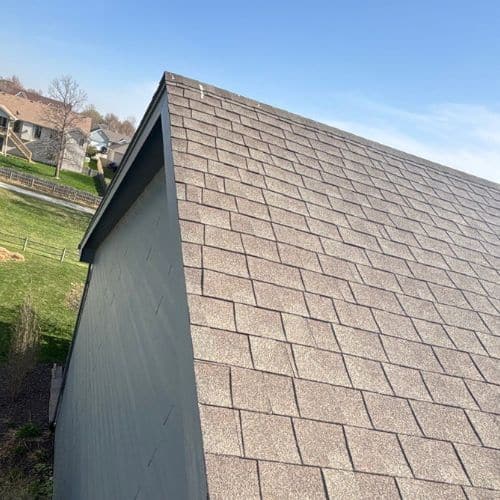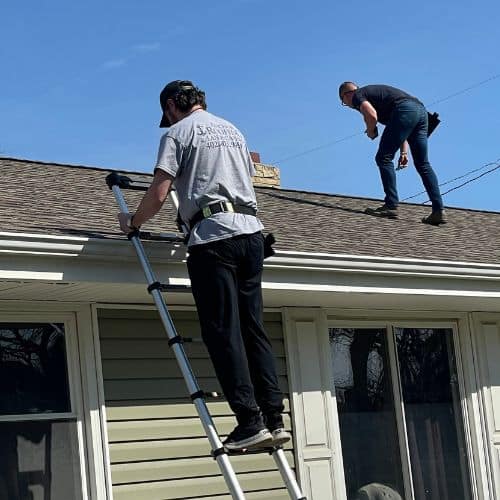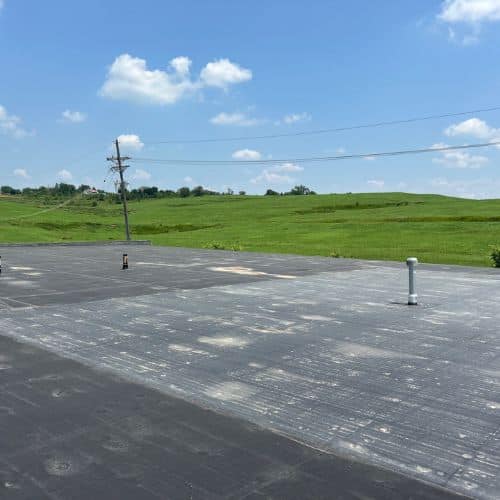Roof Pitch: How It Impacts Your Cost and Home Value
Learn how roof pitch is measured, its impact on cost, and why it matters for your home’s performance and appearance.
As a homeowner, chances are you don’t spend as much time thinking about the pitch of your roof as we do here at Anchor Roofing. But as it turns out, the pitch of your roof is very important, as it plays a role in the cost of your roof, what materials may be used, and the overall aesthetic of your home. But how (and why) does roof pitch impact the cost of a roof, and how is roof pitch measured?
At Anchor Roofing, one of our goals—besides high-quality roofing solutions—is to help educate homeowners about the roof over their heads. So today, we’re sharing a bit more about roof pitch, including how it’s calculated (and communicated), and how it may impact the cost of a new roof.
How Is Roof Pitch Measured?
If you’re concerned that we’re about to take a trip back to geometry class with degrees and angles, don’t worry. Roof pitch is measured based on the “rise” and “run”—that is, how much vertical height the roof gains for every foot of horizontal distance.
Roof pitch is given in the form of a number that looks like a ratio or fraction, such as 3/12 or 8/12. This tells us how many inches your roof rises vertically for every 12 inches of horizontal distance.
For example:
- A 3/12 pitch means your roof rises 3 inches for every 12 inches of horizontal distance
- An 8/12 pitch indicates a steeper roof that rises 8 inches for every 12 horizontal inches
This measurement system provides a standardized way for roofing professionals to communicate about roof steepness without complex geometric angles.

How to Measure Your Roof's Pitch
You can determine your roof’s pitch with these simple steps:
- Place a level horizontally against your roof rafters
- Measure 12 inches along the level from the roof contact point
- Measure the vertical distance from the level to the roof at that 12-inch mark
- The vertical measurement in inches is your roof’s pitch (X/12)
Common Roof Pitches and Their Applications

| Pitch Range | Classification | Common Applications | Ideal For |
|---|---|---|---|
| 1/12 – 3/12 | Low Slope | Commercial buildings, porches, modern homes | Areas with minimal precipitation |
| 4/12 – 6/12 | Medium | Most residential homes, ranch styles | Balanced performance in various climates |
| 7/12 – 9/12 | Medium-High | Colonial, Victorian, Craftsman styles | Areas with moderate snowfall or rainfall |
| 10/12+ | Steep | Gothic, Tudor, Alpine chalets | Regions with heavy snow or rain |
Many homes feature multiple pitches, with steeper sections for the main roof and lower slopes for porches or additions. According to industry data, approximately 65% of residential roofs in the Midwest fall within the 4/12 to 8/12 range.

What Are the Most Common Pitches for Roofs?
In residential roofing, most roofs will fall somewhere between 4/12 and 8/12. A pitch of 3/12 or lower is generally considered “low slope,” a style of roof that is much more common in commercial roofing contexts. Meanwhile, pitches of 12/12 (or even higher!) are considered “steep.”
That said, not all roofs have just one pitch. In fact, many homes may have a couple of different pitches, depending on the style and complexity of the roof’s design. For example, while low slope roofs are uncommon in residential roofing, a low slope may be used to cover a porch or other portion of the home.
How Roof Pitch Impacts the Cost of a Roof Replacement
A roof replacement is a major investment, but depending on the style of your roof, and the roof pitch in particular, that cost may be higher or lower.
A steeper roof pitch generally increases the cost of your roof replacement in a variety of ways, including:
- Higher volume of roofing materials is required due to the greater surface area
- Greater difficulty in completing a steep roof installation
- Specific materials may be required

Let’s take a closer look at each.
1. More Materials Needed
This first factor is just simple math: generally speaking, the steeper your roof is, the more roof you have. That means replacing a roof with a 12/12 pitch will take significantly more material than one with a 4/12 pitch. This need for more materials will add up to a greater upfront cost.
2. Increased Installation Difficulty
Roof pitch dramatically affects installation difficulty:
- Walkable roofs (typically under 7/12) allow roofers to move freely without special equipment
- Steeper roofs require additional safety harnesses, scaffolding, and specialized techniques
- Labor costs can increase by 25-40% for very steep roofs due to slower installation times and safety requirements
3. Specific Products Required
While a lesser factor than the first two, a steeper roof may narrow your options when it comes to which products may be installed on your roof. Products will generally have specifications for the required roof pitch, and extremely steep roofs may only be compatible with a handful of materials.
4. Long-Term Value Considerations
While steeper roofs may cost more initially, they often provide benefits that improve long-term value:
- Better water shedding and drainage
- Reduced risk of leaks and water damage
- Improved attic ventilation
- Enhanced curb appeal and architectural interest
- Potential energy efficiency improvements

Anchor Roofing: Roof Replacement Experts in Omaha
At Anchor Roofing, our team has extensive experience working with roofs of all pitches and designs. Whether you have a complex roof design or an extremely steep pitch, we can handle your roof replacement with expertise and precision. Contact our team today to schedule an inspection and receive a detailed quote tailored to your roof’s specific characteristics.
Common Questions About Roof Pitch
Yes, but this represents a significant structural change requiring engineering plans, permits, and possibly foundation reinforcement. Expect costs to increase by 50-100% compared to a standard replacement.
Steeper pitches can improve energy efficiency by 10-15% in some climates by creating more attic space for insulation and improved ventilation, reducing cooling costs during the summer months.
Most insurance policies cover roof replacements regardless of pitch, but some may charge higher premiums for very steep roofs due to increased replacement costs and potential safety concerns.
